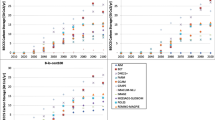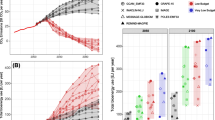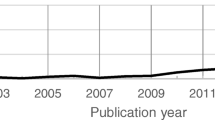Abstract
This study investigates the use of bioenergy for achieving stringent climate stabilization targets and it analyzes the economic drivers behind the choice of bioenergy technologies. We apply the integrated assessment framework REMIND-MAgPIE to show that bioenergy, particularly if combined with carbon capture and storage (CCS) is a crucial mitigation option with high deployment levels and high technology value. If CCS is available, bioenergy is exclusively used with CCS. We find that the ability of bioenergy to provide negative emissions gives rise to a strong nexus between biomass prices and carbon prices. Ambitious climate policy could result in bioenergy prices of 70 $/GJ (or even 430 $/GJ if bioenergy potential is limited to 100 EJ/year), which indicates a strong demand for bioenergy. For low stabilization scenarios with BECCS availability, we find that the carbon value of biomass tends to exceed its pure energy value. Therefore, the driving factor behind investments into bioenergy conversion capacities for electricity and hydrogen production are the revenues generated from negative emissions, rather than from energy production. However, in REMIND modern bioenergy is predominantly used to produce low-carbon fuels, since the transport sector has significantly fewer low-carbon alternatives to biofuels than the power sector. Since negative emissions increase the amount of permissible emissions from fossil fuels, given a climate target, bioenergy acts as a complement to fossils rather than a substitute. This makes the short-term and long-term deployment of fossil fuels dependent on the long-term availability of BECCS.




Similar content being viewed by others
Notes
There are other options to generate net negative emissions, e.g., direct air capture technologies and afforestation. In contrast to biomass, they are not usable as primary energy carriers.
This emission factor was estimated from MAgPIE results and assuming a global warming potential of 298 for N2O. Van Vuuren et al. 2010c report a similar value of 2.93 kg CO2 eq/GJ.
The direct equivalent method was used for primary energy accounting. Since it accounts one unit of non-biomass renewable or nuclear energy for roughly three units of fossil fuels in electricity production, it tends to understate the contribution of renewables or nuclear in primary energy supply. Reductions in primary energy are partly due to a shift from fossil fuel combustion to non-biomasss renewables and nuclear energy.
References
Azar et al (2010) The feasibility of low CO2 concentration targets and the role of bio-energy with carbon capture and storage. Clim Chang 100:195–202
Bauer N et al (2012a) The REMIND–R model: the role of renewables in the low–carbon transformation—first–best vs. second–best worlds. Clim Chang 114:145–168
Bauer N et al (2012b) Economics of nuclear power and climate change mitigation policies. Proc Natl Acad Sci U S A 109(42):16805–16810
Bodirsky B et al (2012) Current state and future scenarios of the global agricultural nitrogen cycle. Biogeosci Discuss 9:2755–2821
Bondeau A et al (2007) Modelling the role of agriculture for the 20th century global terrestrial carbon balance. Glob Chang Biol 13(3):679–706
Calvin K et al (2009) Limiting climate change to 450 ppm CO2 equivalent in the 21st century. Energy Econ 31:S107–S120
Chum H et al (2011) Bioenergy. In: IPCC special report on renewable energy sources and climate change mitigation. Cambridge University Press, Cambridge, United Kingdom and New York, NY, USA, p 1075
Creutzig F et al (2012) Reconciling top-down and bottom-up modelling on future bioenergy deployment. Nat Clim Chang 2:320–327
Dietrich JP et al (2013) Forecasting technological change in agriculture—an endogenous implementation in a global land use model. Technol Forecast Soc Chang. doi:10.1016/j.techfore.2013.02.003
Edenhofer O et al (2010) The economics of low stabilization: model comparison of mitigation strategies and costs. Q J IAEE’s Energy Econ Educ Found 31:11–48 (Special Issue)
Fargione J et al (2008) Land clearing and the biofuel carbon debt. Science 319:1235–1238
Fischedick M et al (2011) Mitigation potential and costs. In: IPCC special report on renewable energy sources and climate change mitigation. Cambridge University Press, Cambridge, United Kingdom and New York, NY, USA
Haberl H et al (2010) The global technical potential of bio-energy in 2050 considering sustainability constraints. Curr Opin Environ Sustain 2:394–403
Krause M et al (2012) Conservation of undisturbed natural forests and economic impacts on agriculture. Land Use Policy 30:344–354
Kriegler E et al (2013a) Is atmospheric carbon dioxide removal a game changer for climate change mitigation? Clim Chang 118:45–57
Kriegler E et al (2013b) The role of technology for achieving climate policy objectives: overview of EMF27 study on technology and climate policy strategies. Clim Chang (this issue)
Leimbach M et al (2010a) Mitigation costs in a globalized world: climate policy analysis with REMIND–R. Environ Model Assess 15:155–173
Leimbach M et al (2010b) Technological change and international trade – insights from REMIND–R. Energy J 31:109–136
Lotze-Campen H et al (2008) Food demand, productivity growth and the spatial distribution of land and water use: a global modeling approach. Agric Econ 39:325–338
Lotze-Campen H et al (2010) Scenarios of global bioenergy production: the trade-offs between agricultural expansion, intensification and trade. Ecol Model 221:2188–2196
Lucas PL et al (2007) Long-term reduction potential of non-CO2 greenhouse gases. Environ Sci Policy 10:85–103
Luckow P et al (2010) Large-scale utilization of biomass energy and carbon dioxide capture and storage in the transport and electricity sectors under stringent CO2 concentration limit scenarios. Int J Greenh Gas Control 4:865–877
Luderer G et al (2012) Asia’s role in mitigating climate change: a technology and sector specific analysis with REMIND–R. Energy Econ 34:S378–S390
Luderer G et al (2013) Description of the REMIND-R model. Technical Report, Potsdam Institute for Climate Impact Research. http://www.pik-potsdam.de/research/sustainable-solutions/models/remind/description-of-remind-v1.5
Meinshausen M et al (2011) Emulating coupled atmosphere–ocean and carbon cycle models with a simpler model, MAGICC6—Part 1: model description and calibration. Atmos Chem Phys 11:1417–1456
Obersteiner M et al (2001) Managing climate risk. Science 294:786–787
Popp A et al (2011) The economic potential of bioenergy for climate change mitigation with special attention given to implications for the land system. Environ Res Lett 6(3):034017. doi:10.1088/1748-9326/6/3/034017
Popp A et al (2012) Additional CO2 emissions from land use change: forest conservation as a precondition for sustainable production of second-generation bioenergy. Ecol Econ 74:64–70
Popp A et al (2013) Land-use transition for bioenergy and climate stabilization: model comparison of drivers, impacts and interactions with other land use based mitigation options. Clim Chang (this issue)
Riahi K et al (2007) Scenarios of long-term socio-economic and environmental development under climate stabilization. Technol Forecast Soc Sci 74:887–935
Searchinger T et al (2008) Use of U.S. croplands for biofuels increases greenhouse gases through emissions from land-use change. Science 319:1238–1240
Sims R et al (2010) An overview of second-generation biofuel technologies. Bioresour Technol 101:1570–1580
Tavoni M et al (2013) Modeling meets science and technology: an introduction to a special issue on negative emissions. Clim Chang 118:1–14
van Vuuren D et al (2009) Future bio-energy potential under various natural constraints. Energy Policy 37:4220–4230
van Vuuren D et al (2010a) Bioenergy use and low stabilization scenarios. Energy J 31:193–221
van Vuuren D et al (2010b) The relationship between short-term emissions and long-term concentration targets. Clim Chang 104:793–801
van Vuuren D et al (2010c) Exploring IMAGE model scenarios that keep greenhouse gas radiative forcing below 3 W/m2 in 2100. Energy Econ 32:1105–1120
Wise M et al (2009) Implications of limiting CO2 concentrations for land use and energy. Science 324:1183–1186
Zoback MD, Gorelick StM (2012) Earthquake triggering and large-scale geologic storage of carbon dioxide. PNAS 109(26):10164–10168
Acknowledgments
The research leading to these results has received support from the ERMITAGE project funded by the Seventh Framework Programme (FP7/2007-2013) under grant agreement n° 265170.
Author information
Authors and Affiliations
Corresponding author
Additional information
This article is part of the Special Issue on “The EMF27 Study on Global Technology and Climate Policy Strategies” edited by John Weyant, Elmar Kriegler, Geoffrey Blanford, Volker Krey, Jae Edmonds, Keywan Riahi, Richard Richels, and Massimo Tavoni.
Electronic supplementary material
Below is the link to the electronic supplementary material.
ESM 1
(PDF 771 kb)
Rights and permissions
About this article
Cite this article
Klein, D., Luderer, G., Kriegler, E. et al. The value of bioenergy in low stabilization scenarios: an assessment using REMIND-MAgPIE. Climatic Change 123, 705–718 (2014). https://doi.org/10.1007/s10584-013-0940-z
Received:
Accepted:
Published:
Issue Date:
DOI: https://doi.org/10.1007/s10584-013-0940-z




